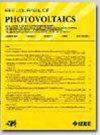光谱辐照度聚集到加藤波段和pv波段对光伏光谱效应估计的影响
IF 2.6
3区 工程技术
Q3 ENERGY & FUELS
引用次数: 0
摘要
全分辨率光谱辐照度数据在单个时间步长可包含2000-3000个数据点。鉴于光伏(PV)建模是在多年周期内以亚小时时间分辨率定期进行的,因此在文件大小和计算负担方面,合并光谱效应可能会变得具有挑战性。出于这个原因,光谱辐照度有时被聚合到有限数量的波长带(或波段)中,例如IEC 61853系列标准中使用的32波段分组称为加藤波段,用于“光伏模块性能测试和能量等级”。为了测试这种聚集的影响,我们使用了来自美国两个地点——亚利桑那州坦佩和科罗拉多州戈尔登——的测量和建模光谱辐照度数据来评估将光谱辐照度聚集到加藤波段和另外两组被称为PV波段的波段对PV光谱效应估计的影响。对于晶体硅和碲化镉模块,使用聚合光谱的计算与使用全分辨率光谱的计算进行了比较。三组波段中的每一组在光谱降额因子(表征长期光谱效应)中产生小于0.1%的可忽略误差。这表明,加藤波段和PV波段都应该足以达到PV能量等级的目的。与此同时,最新版本的PV波段在评估瞬时光谱失配因子方面表现最好,在所有时间步长中,无论是在站点还是光伏组件技术上,误差都小于0.2%,而Kato波段的瞬时误差高达1.4%。本文章由计算机程序翻译,如有差异,请以英文原文为准。
The Impact of Spectral Irradiance Aggregation Into Kato Bands and PV-Bands on Estimates of Photovoltaic Spectral Effects
Full-resolution spectral irradiance data can comprise upwards of 2000–3000 data points at a single time step. Given that photovoltaic (PV) modeling is regularly performed with subhourly time resolutions over multiyear periods, incorporating spectral effects can become challenging both in terms of file sizes and computational burden. For this reason, spectral irradiances are sometimes aggregated into a limited number of wavelength bands (or wavebands), such as the 32-band grouping known as Kato bands that is used in the IEC 61853 series of standards on “PV module performance testing and energy rating.” To test the impact of such aggregation, measured, and modeled spectral irradiance data from two sites in the United States—Tempe, Arizona and Golden, Colorado—are used to assess the impact on PV spectral effect estimates of aggregating spectral irradiances into Kato bands and into two other sets of wavebands known as PV-bands. Calculations using the aggregated spectra are compared with those using the full-resolution spectra, for crystalline silicon and cadmium telluride modules. Each of the three sets of wavebands yields negligible errors of less than 0.1% in the spectral derate factor, which characterizes long-term spectral effects. This indicates that both Kato bands and PV-bands should be sufficient for the purposes of PV energy rating. Meanwhile, a recent version of PV-bands performs best for evaluating the instantaneous spectral mismatch factor, leading to errors of less than 0.2% across all time steps for both sites and PV module technologies, while instantaneous errors for Kato bands reach magnitudes of up to 1.4%.
求助全文
通过发布文献求助,成功后即可免费获取论文全文。
去求助
来源期刊

IEEE Journal of Photovoltaics
ENERGY & FUELS-MATERIALS SCIENCE, MULTIDISCIPLINARY
CiteScore
7.00
自引率
10.00%
发文量
206
期刊介绍:
The IEEE Journal of Photovoltaics is a peer-reviewed, archival publication reporting original and significant research results that advance the field of photovoltaics (PV). The PV field is diverse in its science base ranging from semiconductor and PV device physics to optics and the materials sciences. The journal publishes articles that connect this science base to PV science and technology. The intent is to publish original research results that are of primary interest to the photovoltaic specialist. The scope of the IEEE J. Photovoltaics incorporates: fundamentals and new concepts of PV conversion, including those based on nanostructured materials, low-dimensional physics, multiple charge generation, up/down converters, thermophotovoltaics, hot-carrier effects, plasmonics, metamorphic materials, luminescent concentrators, and rectennas; Si-based PV, including new cell designs, crystalline and non-crystalline Si, passivation, characterization and Si crystal growth; polycrystalline, amorphous and crystalline thin-film solar cell materials, including PV structures and solar cells based on II-VI, chalcopyrite, Si and other thin film absorbers; III-V PV materials, heterostructures, multijunction devices and concentrator PV; optics for light trapping, reflection control and concentration; organic PV including polymer, hybrid and dye sensitized solar cells; space PV including cell materials and PV devices, defects and reliability, environmental effects and protective materials; PV modeling and characterization methods; and other aspects of PV, including modules, power conditioning, inverters, balance-of-systems components, monitoring, analyses and simulations, and supporting PV module standards and measurements. Tutorial and review papers on these subjects are also published and occasionally special issues are published to treat particular areas in more depth and breadth.
 求助内容:
求助内容: 应助结果提醒方式:
应助结果提醒方式:


